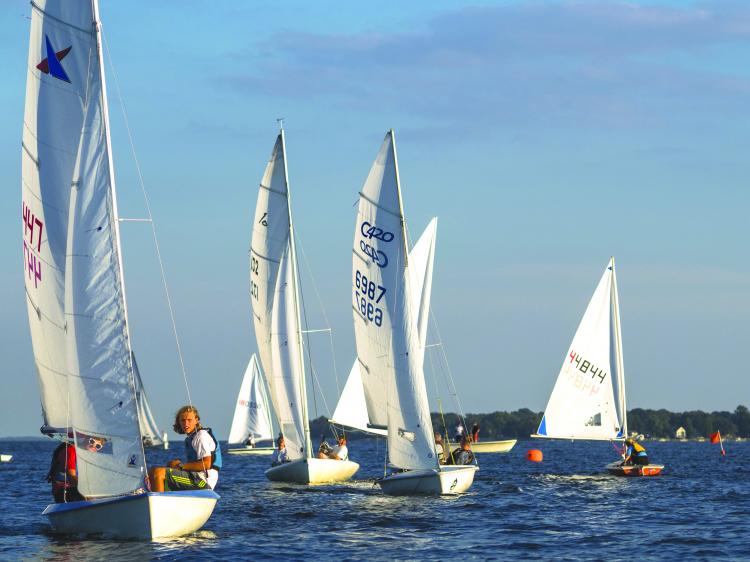In Low-Key Multiclass Regattas, Try Low-Risk Maneuvers
Most championship regattas are run as stand-alone events, with only one type of dinghy or keelboat on the racecourse, giving competitors a (somewhat) simplified situation. But, especially early on in the year we often find ourselves sailing in regattas where more than one kind of boat is racing in the same area.

These “multiclass” regattas are frequently charity regattas, designed to get as many boats as possible out on the water. Often, they are low-key club events, where getting lots of people out racing, relative to the number of race committee boats and volunteers, is important. With so many active one-design classes and only so many weekends available for racing, inevitably, we have to share our playground.
Multiclass events can be super fun as you get to hang out onshore with new people. They can also be incredibly frustrating, as boats that perform differently encounter each other on the water in seemingly always critical junctures of the race—I’m thinking the last few tacks on the final beat, mark roundings, starting/finishing on the same line, etc.
Well, you’re there, and you can’t just imagine the other boats away. So take a deep breath, accept reality, and get your chess mind working: Thinking several steps ahead is key to success.
Clearly, different boats can be faster/slower, point higher/lower upwind, and take dramatically different courses downwind. Some thrive in light air; others just eat things up in heavy air. As you approach a multiclass regatta, consider what other boats will be out on the racecourse with you and learn about their different performance attributes.
In general, boats with longer waterlines will go faster, but if they are light for their size, they may have an extra gear in light air. Downwind some boats often sail by the lee (for example, Lasers); some boats can sail dead downwind (many keelboats), and some boats zip around on more of a reach (many of the boats with asymmetrical chutes). Boats with taller masts generally have more sail area (note: if you’re the boat with the taller mast and resulting more sail area, don’t be a jerk—pass to leeward when you can!).
Coming around the top mark in your classic-style spinnaker boat, do you see an a-sim on starboard a few boatlengths down the course? Also, see a puff coming from the top left corner of the course that you really want to stay high for? While bearing off, setting your spinnaker, and staying a bit high to catch that puff might work in the short term, you need to keep an eye on the few-chess-moves-ahead scenario. Would you get caught above a reaching boat that simply has no way to sail further downwind, as you’ll want to? Maybe it’s best then to use some of that early puff to stay low, avoiding the traffic of a boat that could keep you from heading where you want to go.
Don’t be too insistent about the rules if you are “right”; there may be a more effective way for you to work out of a situation. For example, if you’re sailing along happily upwind on starboard and really want to keep heading left, but a boat on port is headed your way (and you know that kind of boat points really well relative to your boat), it’s likely not optimal to holler at them to tack. They may indeed plant a tight lee-bow on you, sail normally (for them) upwind, and end up pinching you off, forcing you to do two extra tacks (if you do indeed tack back toward the left) or off to your not-preferred side of the course. Instead, the few seconds of sailing lower than ideal to let them cross could be worth it.
As hard as our race committees work to get the timing right—usually sending the faster classes out first followed by progressively slower classes—sometimes things just don’t quite go according to plan. There are times when, at multiclass regattas, really the only time you see the other classes is at the boat ramp getting back in at the end of the day. Other times, it seems as if on the second lap around, every single boat winds up at the leeward mark at the same time. And they’re all coming in from different angles, at different speeds, and they all have different intentions. (Maybe some are even not rounding the leeward gates, but just going through them on their way to a downwind finish below the gates!)
This is a big “accept reality” situation. Chaos can often seem like an opportunity for big gains: “Hey, those guys are all yelling at each other while they’re going around the leeward mark; maybe they won’t notice me as I try to sneak inside and round while they’re busy hollering.” And yes, on rare occasions, maybe that could work. But why not try the low-risk maneuver? Maybe round the other gate, if it’s not horribly unfavored. Maybe keep your boatspeed up as they’re tangled together and just go outside the crowd but faster than everyone else. Avoiding the chaos can be hugely advantageous.
And just like sailing within a one-design class, getting to know your competitors can make mark roundings and other tight situations work out more smoothly. Take the time to share a beverage with sailors from other classes—you’ll not only learn more about their boats (and how to sail near them), you’ll likely get to know more fun fellow sailors!
~by Kim Couranz




